Nuclear Arms Control & Nonproliferation Diplomacy by Stephen Herzog
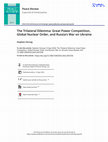
Peace Review, 2024
Scholars and policy analysts have debated the health of the global nuclear order since the beginn... more Scholars and policy analysts have debated the health of the global nuclear order since the beginning of Russia’s February 2022 full-scale invasion of Ukraine. Their analysis often yields disturbing predictions about the future of the nonproliferation regime, arms control, and the “taboo” against using nuclear weapons. This article concludes, however, that the components of this longstanding order are durable. They have proven robust to Russian nuclear threats, just as they did in the face of past great power transgressions. Yet, cracks are forming that will require attention in the long run as the nuclear order built by Washington and Moscow adapts to Beijing’s emergence. The best remedy appears to be enhanced trilateral cooperation between China, Russia, and the United States. Active Chinese participation is necessary to sustain the global nuclear order due to—and in spite of—great power competition.
The Altered Nuclear Order in the Wake of the Russia-Ukraine War, 2023
In their essay, Rebecca Davis Gibbons and Stephen Herzog assess how the nuclear dynamics of Russi... more In their essay, Rebecca Davis Gibbons and Stephen Herzog assess how the nuclear dynamics of Russia’s war on Ukraine have impacted the Treaty on the Prohibition of Nuclear Weapons' (TPNW) efforts to eliminate nuclear weapons. The authors evaluate predictions from scholarly literature, evolving state positions, implications for public opinion, and how actual nuclear weapon use may alter the international climate.
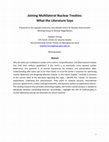
Working paper, 2023
Why do states join multilateral nuclear arms control, nonproliferation, and disarmament treaties ... more Why do states join multilateral nuclear arms control, nonproliferation, and disarmament treaties that limit their military capabilities? If the world is to eventually move beyond nuclear deterrence, this question is of pivotal importance for scholars and policymakers alike. Understanding why states opt to tie their hands vis-à-vis the bomb is essential for optimizing nuclear diplomacy and designing effective treaties. In this report chapter, I provide a summary of the current state of the literature regarding this topic. I identify five "camps" of scholarly explanations underlying this phenomenon. They point to national security, international pressure, global norms, treaty-contingent benefits, and domestic politics as explanatory factors. The existing research thus provides interesting insights, but further careful analysis is needed to adjudicate between contending theories. Accordingly, I highlight the role of multicausality in nuclear diplomacy and lay out directions for future research.
Journal for Peace and Nuclear Disarmament, 2023
Stephen Herzog reviews "The Hegemon’s Tool Kit: US Leadership and the Politics of the Nuclear Non... more Stephen Herzog reviews "The Hegemon’s Tool Kit: US Leadership and the Politics of the Nuclear Nonproliferation Regime" by Rebecca Davis Gibbons, published by Cornell University Press in 2022.
Carnegie Endowment for International Peace, 2023
We break down possible rationales for South Korean President Yoon Suk-yeol's recent (Jan. 2023) c... more We break down possible rationales for South Korean President Yoon Suk-yeol's recent (Jan. 2023) comments about potential development of nuclear weapons or re-deployment of U.S. tactical nuclear weapons to the Korean Peninsula. Our discussion includes coverage of "nuclear populism" and security drivers of such rhetoric, the costs of proliferation, and recommendations for U.S. policy.
Science, 2022
In October 1962, the United States and the Soviet Union squared off in what game theorist and Nob... more In October 1962, the United States and the Soviet Union squared off in what game theorist and Nobel laureate Thomas Schelling described as a nuclear game of "chicken" that threatened humanity's survival. The Cuban Missile Crisis spurred six decades of efforts to limit the spread of nuclear weapons and inspired a generation of scientists to think critically about reducing atomic risks. Russian President Vladimir Putin's recent nuclear threats during the war in Ukraine are an unambiguous reminder that such dangers have outlived the Cold War. A new wave of scientific research is urgently needed to understand conditions for making global nuclear disarmament desirable and feasible.
Arms Control Today, 2022
This article discusses the entry-into-force of the Treaty on the Prohibition of Nuclear Weapons (... more This article discusses the entry-into-force of the Treaty on the Prohibition of Nuclear Weapons (TPNW) in January 2021, the first Meeting of States Parties in June 2022, and challenges that Russia's invasion of Ukraine in February 2022 may pose to the agreement moving forward.

Survival, 2022
The global nuclear order had been challenged in recent years by individual proliferators, the mor... more The global nuclear order had been challenged in recent years by individual proliferators, the moribund US–Russian arms-control process and resultant frustration over stalled progress towards disarmament. Then Russia launched its full-scale invasion of Ukraine under cover of nuclear threats against NATO. This has neither exposed the international nuclear-governance regime as toothless nor brought it to the verge of collapse. The global nuclear order’s history shows its resilience to rogue acts by great powers. It will continue to serve key nuclear-capable states’ security and energy interests in the non-proliferation domain. Arms control between Washington and Moscow has always been sensitive to their strategic whims and can be reconstituted. The main consequence of Russian President Vladimir Putin’s war is renewed public awareness of the often unpalatable role nuclear weapons play in international politics. Nuclear targeting, deterrent threats and associated risk-reduction efforts are hardly new phenomena.

Nuclear Non-Proliferation in International Law - Volume VI, 2021
What roles can small militarily non-aligned States play in nuclear non-proliferation diplomacy wi... more What roles can small militarily non-aligned States play in nuclear non-proliferation diplomacy with actual or suspected proliferators? And how might international law shape such contributions? Current literature identifying effective approaches to nuclear non-proliferation and rollback is somewhat one-dimensional, emphasising the behaviour of great powers and international organisations. By contrast, this chapter analyses activities militarily non-aligned States may undertake supporting negotiations in accordance with international legal norms and institutions. More specifically, it explores Swedish and Swiss initiatives in the early 2000s, a period of growing tensions over the Iranian and North Korean nuclear programmes. Drawing upon resources including unpublished elite interviews, the chapter offers new insights into theoretical backchannel non-proliferation mechanisms. It complements existing literature on nuclear proliferation by offering a fuller account of diplomatic negotiations. Ongoing crises suggest many future challenges to the non-proliferation regime will emerge, and militarily non-aligned States may hold one of the few keys to facilitating dialogue. International law can both compel these States to act and provide them with influential—but often-overlooked—non-proliferation roles. Indeed, reconsidering dominant narratives about ‘players’ involved in nuclear diplomacy may provide new avenues for policy-making and theorising aimed at preventing the spread of nuclear weapons.

Journal for Peace and Nuclear Disarmament, 2020
Horizontal nuclear proliferation presents what is sometimes referred to as the “Nth country probl... more Horizontal nuclear proliferation presents what is sometimes referred to as the “Nth country problem,” or identifying which state could be next to acquire nuclear weapons. Nuclear fuel cycle technologies can contribute to both nuclear power generation and weapons development. Consequently, observers often view civilian nuclear programs with suspicion even as research on nuclear latency and the technological inputs of proliferation has added nuance to these discussions. To contribute to this debate, I put forth a simple theoretical proposition: En route to developing a civilian nuclear infrastructure and mastering the fuel cycle, states pass through a proliferation “danger zone.” States with fuel cycle capabilities below a certain threshold will likely be unable to proliferate. States that pass through the “danger zone” without proliferating will be unlikely to do so in the future. I support this proposition by introducing preliminary analysis from the Nuclear Fuel Cycle (NFC) Index, a new heuristic tool to complement political assessments of the connection between civilian nuclear energy development and nuclear weapons proliferation. I conclude with policy implications for contemporary Iran, Saudi Arabia, Japan, and South Korea. Taken together, this article calls for increased policymaker interaction with historical cases and more sophisticated academic engagement with the nuclear fuel cycle.
Bulletin of the Atomic Scientists, 2020
The administration of President Donald J. Trump has consistently used fear of China to undermine ... more The administration of President Donald J. Trump has consistently used fear of China to undermine nearly five decades of bipartisan consensus on US–Russian nuclear arms control. The negative consequences of these actions may last far beyond the Trump presidency. If generations of agreement between Democrats and Republicans on bilateral nuclear treaties with Russia erode, it will pose a significant setback to US national security and global stability. Future leaders may ultimately need to consider new approaches to nuclear risk reduction that preserve the benefits of the arms control regime.
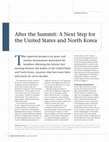
Arms Control Today, 2018
This article discusses the potential utility of the Comprehensive Nuclear-Test-Ban Treaty (CTBT) ... more This article discusses the potential utility of the Comprehensive Nuclear-Test-Ban Treaty (CTBT) as a litmus test of North Korean Supreme Leader Kim Jong-un's actual interest in nuclear disarmament. Now that the public show of the Singapore Summit with U.S. President Donald Trump is over, the difficult work toward nuclear disarmament begins. The most promising near-term option to build U.S.-North Korean confidence and make meaningful progress toward nuclear disarmament is to obtain Pyongyang’s signature on and ratification of the CTBT. If Kim is serious about turning back the clock on his nuclear program, permanent cessation of nuclear testing should be mutually agreeable. The treaty would restrict North Korean nuclear weapons development and lock the regime into arms control commitments. Further, it would open the door for representatives of the Comprehensive Nuclear-Test-Ban Treaty Organization (CTBTO) to verify the recently declared closure of the nuclear test site at Punggye-ri.
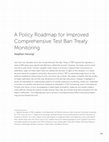
Project on Nuclear Issues: A Collection of Papers from the 2017 Conference Series and Nuclear Scholars Initiative, 2018
Just over two decades since the Comprehensive Test Ban Treaty (CTBT) opened for signature, a tota... more Just over two decades since the Comprehensive Test Ban Treaty (CTBT) opened for signature, a total of 183 states have signed and 166 have ratified the accord. However, the treaty cannot enter into force until all 44 “nuclear-capable” states listed in its Annex 2 deposit their instruments of ratification. Eight of these states have not ratified the test ban. In light of this situation, it is nearly second nature for academic and policy discussions of the CTBT to overwhelmingly focus on the political roadblocks obstructing its entry into force. By contrast, this paper contends that the politics of treaty ratification are not the only dimension to the test ban discussion. Instead, it highlights a series of overlooked or understudied aspects of nuclear explosion monitoring. States can undertake a number of scientific and technical initiatives to strengthen CTBT monitoring, even in the absence of entry into force. In turn, by engaging in these types of projects, states do not merely create a more difficult climate for evasive nuclear testing; they may also bolster long-term prospects for the treaty’s ratification. This roadmap lays out a number of complementary efforts that policymakers may pursue toward this end.

Nuclear Scholars Initiative: A Collection of Papers from the 2012 Nuclear Scholars Initiative, 2012
Policy analyses of underground test monitoring in support of the Comprehensive Nuclear Test Ban T... more Policy analyses of underground test monitoring in support of the Comprehensive Nuclear Test Ban Treaty (CTBT) usually focus on the Primary and Auxiliary Seismological Networks of the International Monitoring System (IMS). In addition to overlooking National Technical Means (NTM), this lens fails to consider thousands of seismic stations and arrays operated by government agencies, universities , and research institutes. These networks serve important functions in earthquake hazard mitigation, tsunami warning systems, and civilian and military disaster responses, but they can also detect waveform data from suspected nuclear tests. This paper explores mechanisms for seismic data sharing in the scientific community and evaluates their potential contributions to CTBT monitoring. It concludes that seismology is the first line of sight for monitoring underground nuclear tests, and scientific data sharing and capacity building can help to detect and deter noncompliance with the CTBT.
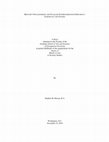
Georgetown University Security Studies M.A. Thesis, 2010
This thesis analyzes the contributions of the European militarily nonaligned states—Austria, Finl... more This thesis analyzes the contributions of the European militarily nonaligned states—Austria, Finland, Ireland, Sweden, and Switzerland—to nuclear nonproliferation discussions with actual or suspected proliferators. I isolate two hypotheses. First, the relatively close relationships that these states often have with proliferators enable them to play key roles in nonproliferation discussions. Second, it is possible to identify certain types of roles and policy activities that have facilitated these states’ contributions to nuclear nonproliferation diplomacy. I test these hypotheses by examining case studies of Swedish and Swiss efforts to enhance dialogue between Iran, North Korea, and their U.S. and European Union interlocutors. My analysis supported the first hypothesis. Economic and diplomatic ties with proliferants, and the ability to pursue autonomous foreign policy agendas, have enabled Sweden and Switzerland to act as intermediaries in nonproliferation talks. The data also supported the second hypothesis. Militarily nonaligned states have contributed to nonproliferation efforts by passing messages, holding consultations with negotiating parties, developing compromise proposals, hosting direct talks and track II diplomatic engagements, and influencing the policies of international organizations. Based upon strong support for each hypothesis and the generalizability of my analytic conclusions, this thesis underscores the need for greater inclusion of European militarily nonaligned states in nuclear nonproliferation efforts. Successful employment of these states’ intermediary diplomatic capabilities will require both open-mindedness from negotiating parties and more assertiveness from militarily nonaligned states.
Public Opinion & Nuclear Politics by Stephen Herzog
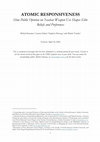
A recent wave of studies using surveys and survey experiments has significantly advanced scholarl... more A recent wave of studies using surveys and survey experiments has significantly advanced scholarly understanding of the microfoundations of the “nuclear taboo.” However, this methodological approach has faced critiques for relying on samples of the general population to study the traditionally elite domain of nuclear policy. In this research note, we address the central question: Can public opinion influence elite views on nuclear weapon use? We bridge this critical gap in the literature with an elite experiment conducted on three samples: U.S. government employees, U.K. government employees, and U.K. parliamentarians. We varied public support for nuclear strikes in realistic scenarios to examine elite responsiveness to public preferences regarding nuclear first use, nuclear retaliation, and third-party nuclear threats. The results highlight three mechanisms through which public opinion can affect elite nuclear decisions. First, high public support notably increases elites’ willingness to endorse nuclear first use against non-nuclear adversaries. Second, in such situations, public backing shapes elite beliefs about their leaders’ willingness to order nuclear strikes. But the effect of public opinion is weaker in nuclear retaliation contexts, suggesting that different considerations become prominent after the nuclear taboo has been breached. Third, sympathetic public opinion strongly influences elite perceptions of the credibility of third-party nuclear threats, carrying implications for the practice of nuclear deterrence. Our findings highlight the potential role of public opinion as both an enabling and constraining force on nuclear weapon use and provide new theoretical and empirical insights into elite decision-making in nuclear politics.
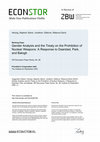
I4R Discussion Paper Series, No. 98, 2023
We are grateful to Haley Daarstad, RyuGyung Park, and Timea Balogh for their thoughtful engagemen... more We are grateful to Haley Daarstad, RyuGyung Park, and Timea Balogh for their thoughtful engagement with our 2022 short article in The Journal of Politics. In that article, we tested the malleability of U.S. public support for nuclear disarmament, specifically in the context of the 2017 Treaty on the Prohibition of Nuclear Weapons (TPNW). Our survey experiment reveals that––despite majority public support for eliminating nuclear weapons––Americans’ backing of the TPNW can be significantly attenuated by exposure to elite and group cues opposing the treaty. The resultant article has received considerable attention from policymakers and anti-nuclear activists alike.
Daarstad, Park, and Balogh (DPB) offer three main substantive points of comment. First, DPB indicate that our results successfully replicate and note that they “do not find any coding errors that undermine the authors’ analysis or conclusions.” Second, DPB show that our findings also replicate when partisan leaners are coded as political Independents. Finally, and most interestingly, DPB conduct gender-based subgroup analysis and show that there are heterogenous treatment effects among male and female respondents in our sample. We address each of these points in turn.
Bulletin of the Atomic Scientists, 2022
David M. Allison and I provide data analysis to briefly summarize and expand upon our Journal of ... more David M. Allison and I provide data analysis to briefly summarize and expand upon our Journal of Conflict Resolution article with Jiyoung Ko entitled "Under the Umbrella: Nuclear Crises, Extended Deterrence, and Public Opinion."

Journal of Conflict Resolution, 2022
How robust is public support for extended nuclear deterrence in patron and client states? Recent ... more How robust is public support for extended nuclear deterrence in patron and client states? Recent studies have improved scholarly understanding of US public opinion about nuclear weapon use against non-nuclear adversaries. Yet, there is limited knowledge of public attitudes regarding retaliation for nuclear strikes against US allies. We develop a theoretical typology of nuclear crises and investigate this phenomenon with a novel survey experiment (n=6,623). Americans, Japanese, and South Koreans viewed realistic emergency alert messages about a most-likely case for nuclear retaliation: a North Korean missile attack on a US ally protected by the nuclear umbrella. Support for nuclear retaliation is low in all three countries, with important cross-national differences. Favorability increases with North Korean nuclear first-use, but remains limited nonetheless. Surprisingly, US "tripwire" troop casualties do not increase Americans' demands for nuclear retaliation. These findings have important implications for the study of nuclear crises and practice of extended deterrence.
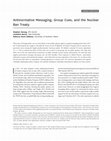
Journal of Politics, 2022
What types of foreign policy cues are most likely to turn public opinion against a popular emergi... more What types of foreign policy cues are most likely to turn public opinion against a popular emerging norm? Since 2017, the U.S. government has sought to discredit the Treaty on the Prohibition of Nuclear Weapons and its nuclear non-possession norm among the largely pro-disarmament American public. We fielded a national U.S. survey experiment (N = 1,219) to evaluate the effects of these elite cues as well as social group cues on public opinion. Our study thus offers one of the first experimental assessments of public attitudes toward nuclear disarmament. We find both negative government messages and group cues can shift attitudes. Direct exposure to official rhetoric — particularly substantive security and institutional critiques — most effectively increases opposition to the norm. Yet, we observe that all cues have little effect on respondents’ existing opposition to nuclear arms. The American population may support eventually eliminating nuclear weapons, but majority backing for immediate disarmament appears far from assured.










Uploads
Nuclear Arms Control & Nonproliferation Diplomacy by Stephen Herzog
Public Opinion & Nuclear Politics by Stephen Herzog
Daarstad, Park, and Balogh (DPB) offer three main substantive points of comment. First, DPB indicate that our results successfully replicate and note that they “do not find any coding errors that undermine the authors’ analysis or conclusions.” Second, DPB show that our findings also replicate when partisan leaners are coded as political Independents. Finally, and most interestingly, DPB conduct gender-based subgroup analysis and show that there are heterogenous treatment effects among male and female respondents in our sample. We address each of these points in turn.
Daarstad, Park, and Balogh (DPB) offer three main substantive points of comment. First, DPB indicate that our results successfully replicate and note that they “do not find any coding errors that undermine the authors’ analysis or conclusions.” Second, DPB show that our findings also replicate when partisan leaners are coded as political Independents. Finally, and most interestingly, DPB conduct gender-based subgroup analysis and show that there are heterogenous treatment effects among male and female respondents in our sample. We address each of these points in turn.